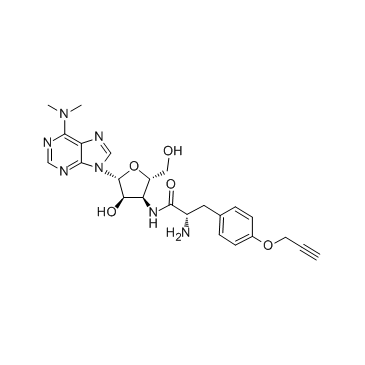| Description |
O-propargyl-puromycin, an alkyne analog of puromycin, is a potent protein synthesis inhibitor.
|
| Related Catalog |
|
| In Vitro |
O-propargyl-puromycin can be used to image and affinity-purify nascent proteins in cells and in animals. O-propargyl-puromycin inhibits protein synthesis, both in reticulocyte lysates and in cultured cells, displaying a potency two- to threefold lower than that of unmodified puromycin. O-propargyl-puromycin forms covalent conjugates with nascent polypeptide chains, which are rapidly turned over by the proteasome and can be visualized or captured by copper(I)-catalyzed azide-alkyne cycloaddition. [1].
|
| In Vivo |
Tissues from uninjected mice shows low nonspecific staining, whereas tissues from O-propargyl-puromycin-injected mice display specific patterns of O-propargyl-puromycin incorporation into nascent proteins. In the small intestine, translation is strongest in cells in the crypts and at the base of intestinal villi, consistent with the high proliferative and secretory activity of these cells. The stain is particularly strong in Paneth cells, which are located close to the base of the crypts and are filled with secretory vesicles. The intense O-propargyl-puromycin labeling of vesicles in Paneth cells suggests that prematurely terminated, O-propargyl-puromycin-conjugated secretory proteins are translocated into the endoplasmic reticulum (ER) lumen[1].
|
| Animal Admin |
Mice: 100 μL of a 20 mM solution of O-propargyl-puromycin in PBS are injected intraperitoneally into a 3-wk-old mouse, and a mouse injected with 100 μL of PBS is used as negative control. Various organs are harvested after 1 h and are fixed in formalin overnight. Organ fragments are embedded in paraffin, sectioned, and ished with xylene to remove the paraffin. After ishing with ethanol and rehydration in TBS, the tissue sections are stained with 20 μM tetramethylrhodamine(TMR)-azide. The tissue sections are counterstained with Hoechst, mounted in standard mounting media, and are then imaged by fluorescence microscopy and DIC[1].
|
| References |
[1]. Liu J, et al. Imaging protein synthesis in cells and tissues with an alkyne analog of puromycin. Proc Natl Acad Sci U S A. 2012 Jan 10;109(2):413-8.
|
